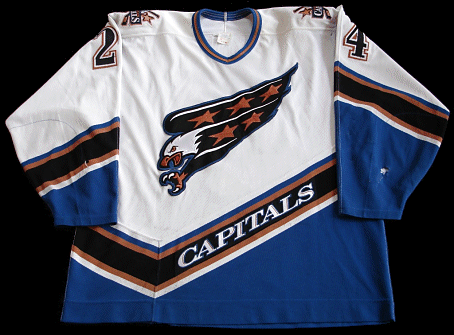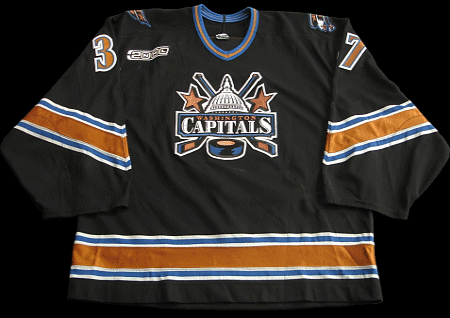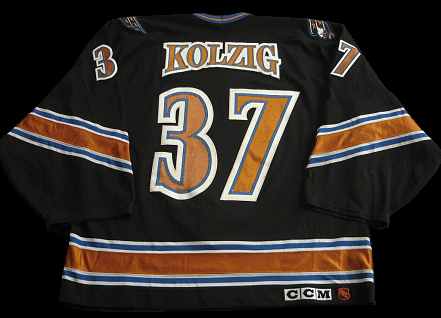1995 - 2005: A Change
On May 25, 1995, The Capitals announced they were changing their colors and logo because they wanted a more contemporary look to attract new and younger fans. The new colors and designs were unveiled on June 22. The change came at a time when the Capitals were losing popularity in the Washington area. They were also losing favor with some of their own players. Kevin Hatcher just didn't want to play in Washington anymore and the Caps were forced to trade him before the 1994-95 season. Brendan Witt, a first round draft pick in 1993 sat out the entire 1994-95 season rather than sign with Washington. Peter Bondra's and Michal Pivonka's contracts both expired at the end of the 1995 season and both were due significant raises. It was not a sure thing that either would be back in Washington for the 95-96 season. The color and uniform change brought a lot of excitement to the team that otherwise would not have been there and in late October, after a 39-day holdout, both Peter Bondra and Michal Pivonka were signed and welcomed back.
Peter Bondra
When Peter Bondra was drafted in the 8th round of the 1990 NHL draft, he wasn't 18 or 19 years old like the rest of his draft class. He was 22! Jack Button, the team's director of player personnel, who had also brought Michal Pivonka to the U.S. a few years earlier, convinced David Poile to take a chance on the late bloomer who had become one of the best goal scorers in the Czech league. Bondra made the team his first year in the U.S. and scored 10 goals in his first 28 games, but then a shoulder injury caused him to miss almonst an entire month. He returned for the final 8 games of the season and had 4 points.

For many years with Washington, Peter Bondra was the lone true goal
scorer on a team that prided itself on its defense. From 1994-95 until 1997-98, no other
Capital scored more than 65 goals. Bondra scored 184. He also had the highest plus/minus
on the team over those 4 seasons. From 1995 through 2003, only Jaromir Jagr had more goals
than Bondra. In his career, Peter Bondra played in 5 NHL All-star games. He won the fastest
skater in the skills competition twice (1997 and 1999). He led the league in goals twice
and finished in the top 10 in goals six times.
On April 3, 1996, Peter Bondra recorded his fourth hat trick of the season in a 5-1 win
over the Buffalo Sabres. The hat trick was recorded with 3 straight goals in the second
period. He would add another in the third to complete his third career 4 goal game. The
goals would be numbers 47, 48, 49, and 50 on the season. This would mark the first 50
goal season for a Capitals player in 11 years. He would record another 50 goal season
and lead the entire league in goals just two seasons later.
Dale Hunter - 1000th Point
Dale Hunter wore this jersey on January 9, 1998 when he scored his 1000th career point. He had 3 assists in the game, which was a 4-1 win over Philadelphia. The jersey is photomatched to the on-ice celebration of the achievement. It is also photomatched to a pre-game ceremony on January 15, in which he was presented with a silver stick from the Capitals owner Abe Pollin.
1997-98 Stanley Cup Playoffs
The 1997-98 Washington Capitals team was decimated by injuries
throughout the regular season. Most of their roster missed a large chunk of time
during the season (Pivonka, Juneau, Tinordi, Nikolishin, Simon, and Klee all missed
more than 25 games). But by the time the playoffs came around, they were mostly
healthy and their defense and goaltending were excellent for the last month of the
season. They finished 4th in the Eastern Conference and drew the Bruins in the
first round. It was a tough six game series with three games going to overtime. The
Bruins outplayed the Caps for long stretches of both games 3 and 4 in Boston,
but the Caps made the most of their opportunities and scored when they got the
chance. They won game 3 in double overtime on Joe Juneau's first of the playoffs
and then Olie Kolzig had a 38 save shutout in game 4. They lost game 5 at home
but Kolzig had another stellar performance in game 6 to close out the series.
The Caps were the only top seed in the East to win their first round series, so
they played the 8th seed Ottawa Senators in round 2. Ottawa had knocked of the top
seed New Jersey Devils, and probably should have beaten the Caps too if it
weren't for the goaltending of Olaf Kolzig. Ottawa outshot Washington in all
five games (168-90 for the series), but Kolzig gave the Caps confidence that they
could take some chances on the offensive end and it worked. The Caps beat the Sens
in 5 games, including 2 more shutouts by Kolzig.
Next up were the Buffalo Sabres and the (soon to be) Hart Trophy winner Dominik
Hasek. Hasek shut out the Caps in game 1, and it looked like it was going to be
a quick series when Buffalo scored late in game 2 to send it to overtime, but
the Caps won in overtime on a huge goal from Todd Krygier and then won in overtime
again in game 3. Kolzig's fourth shutout of the playoffs in game 4 gave the Caps
a 3-1 series lead. The Caps outplayed Buffalo in game 5, but this game belonged
to Hasek as he saved 34 of 35 shots in a 2-1 win. Game 6 was pretty even and had
a very up-tempo pace to it, as both teams were desperately trying to get the first
goal. It wasn't until 13:04 of the second period that a puck finally made it past
one of the goaltenders. Buffalo's Mike Peca scored an unassisted goal, but the
Caps responded with a goal of their own by Esa Tikkanen on the very next shift.
The Sabres outshot the Caps 31-20 through the first two periods, but the score
was tied 1-1. Buffalo scored seven minutes into the third and while the Caps
were making a strong push to tie it, the Sabres took an interference penalty.
Peter Bondra scored his 58th goal of the season (6th of the playoffs) on the
ensuing power play off a beautiful centering pass from Andre Nikolishin and
regulation ended tied at 2. Just six minutes into overtime, a Buffalo defenseman
fanned on a pass at his own blue line. The puck dribbled over to Joe Juneau who
who passed to Brian Bellows. Bellows took the puck down the left wing side past a
Sabres defender, curled into the middle and tried to stuff the puck 5-hole.
Hasek got the paddle of his stick on the puck and as he tried to trap it with
his glove, Juneau pulled it loose and put it in the back of the net to send
the Capitals to their first ever Stanley Cup Finals.

The Detroit Red Wings proved to be too much for the Capitals in the finals as they would sweep the Caps in four games. The Capitals were able to keep it close, losing each of the first three games by just one goal. In fact, they had the game 2 winner on the stick of Esa Tikkanen but it wasn't meant to be. With a 4-3 lead and just over 9 minutes remaining in the third, Tikkanen got a breakaway on Chris Osgood. He faked a slap shot and drew Osgood forward out of his net. As Osgood went to the butterfly, Tikkanen took the puck to his left and had the net wide open in front of him, but he sent the puck wide on the far side. Doug Brown scored 5 minutes later to send it to overtime and Kris Draper ended it at 15:24 of the extra frame. The Red Wings went on to win a close one in game 3, and then closed it out by winning game 4, 4-1.
Olaf Kolzig
After several years in the minors and as a backup, Olaf Kolzig finally
took the starting job away from Vezina winner Jim Carey in the 1996 playoffs.
Olie finished the series with a 0.934 save percentage and a 1.94 GAA (both
tops in the playoffs). In fact, when he retired in 2009, his career playoff save
pct. of 0.927 ranked as the best in the NHL - ever!
In the 1997-98 playoffs, Olie once again played his best when it mattered
most as he carried the Capitals to the Stanley Cup Finals with 4 shutouts
in 21 games.
On January 8, 2000, the Capitals were 14-16-7 - 10th in the Eastern Conference. That night, Olie had a 20 save shutout and he would go 15-1-1 over his next 17 games with a 1.74 GAA. By the end of the season, the Caps had moved up to 2nd in the Eastern Conference and Olie had managed to capture the Vezina trophy.











